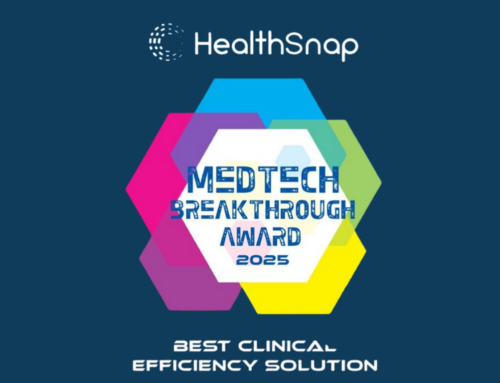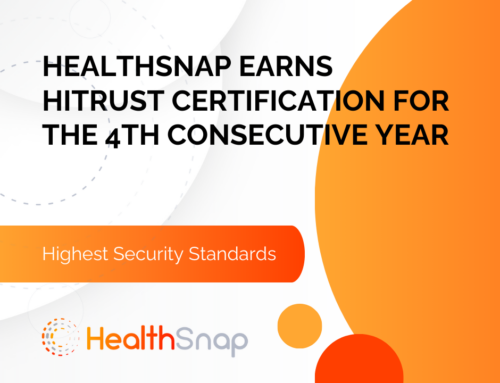Artificial Intelligence (AI) is creating waves in the healthcare sector with a great promise to improve the level of care delivered to patients. Innovators and analysts in the industry are exploring AI’s potential to bring down the costs of care and streamline administrative procedures. The growing capability of AI in healthcare to analyze vast volumes of patient data to find disease patterns, support healthcare research, and offer ways to deliver more effective and affordable patient care are among its most promising aspects at present.
AI Boosts Global Healthcare Delivery and Patient Experience
According to industry forecasts, the volumes of healthcare data generated will continue accelerating in the coming years. The compounded annual growth rate of healthcare data is projected to reach 36% by 2025, exceeding the rates of data generation in virtually every other sector of the economy which says a lot since these are recessionary years.
This growth of healthcare data confronts the business with both obstacles and opportunities. At one end of the spectrum, healthcare practitioners must efficiently manage and evaluate this data to offer high-quality treatment to patients. On the other, the availability of such enormous volumes of data presents a strong opportunity to drive innovation and enhance patient outcomes by applying modern technologies.
The analysis and management of healthcare data is a critical issue, as it impacts global healthcare delivery and the quality of patient experience. Many elements of patient care, such as diagnosis, care plans, and continuous health care management, can benefit from AI. For example, imaging technologies driven by AI in healthcare can assist medical personnel in discovering illnesses at an earlier stage, hence improving the efficacy of treatments. Similarly, AI can help create individualized treatment programs for individuals according to their genetic profiles, clinical records, lifestyle factors, and other variables.
AI in healthcare can also assist healthcare companies in more efficiently managing administrative tasks. For instance, AI-powered chatbots can give patients immediate access to medical information and assistance, relieving the pressure on healthcare staff. Moreover, AI can simplify appointment scheduling, patient data management, and invoicing.
In addition to these particular use cases, AI drives innovation across the healthcare business. By enabling healthcare practitioners to handle and evaluate vast volumes of data swiftly, artificial intelligence is creating new opportunities for research and innovation. In many more aspects, AI has the potential to revolutionize healthcare by making it more efficient, practical, and accessible to people throughout the world – saving money despite inflation.
2023 – A Pivotal Year for AI in Healthcare
While the healthcare industry struggles with the challenges of increasing disease burden, long patient waiting times, clinician burnout and staffing shortages, artificial intelligence is poised to play a crucial role in enhancing efficiency and alleviating the workload of healthcare professionals. In the aftermath of the pandemic, people are more health conscious and expect better delivery of care. At the same time, the issues of an aging population pose an additional challenge because older adults require more healthcare services than younger people do.
With AI in healthcare, medical practitioners can streamline certain aspects of patient visits, lowering the burden on the health system and improving outcomes. AI will increasingly simplify administrative activities, such as organizing appointments, obtaining medical information, and processing insurance claims. With that said, physicians will always be required to manage the interactive component of a healthcare visit and communicate with patients at the point of treatment.
Experts believe that AI is all set to play a crucial role going forward in reducing the chronic disease burden. For instance, AI-powered systems could assist healthcare personnel in identifying patients at high risk of acquiring specific disorders, allowing them to adopt preventative or management measures. In 2022, healthcare professionals were already using some elements of AI for treatment planning and diagnosis. The development of AI-powered medical devices, chatbots, and virtual assistants increased patient access to care.
The expectation is that the use of artificial intelligence in healthcare will continue expanding in 2023 and beyond, with new applications developing and established ones becoming more advanced. The application of AI in precision medicine, the development of AI-powered robotics for surgery and other medical operations, and the use of AI to enhance population health and avoid disease outbreaks are some of the key themes to watch in the coming years.
Overall, 2023 is poised to be a watershed year for AI in healthcare, and as the technology evolves, we can look forward to more promising use cases in the years to come.
Healthcare and Machine Learning
Machine learning is fast becoming an indispensable tool for healthcare professionals and academics, enabling them to evaluate significant volumes of medical data more accurately and in the shortest possible time. Machine learning systems can predict disease outbreaks and development with greater precision, helping healthcare practitioners to build effective preventative and treatment strategies. Diagnosticians employ machine learning to analyze x-rays and other diagnostic testing findings, increasing accuracy and decreasing the possibility of human mistakes.
Machine learning has enabled physicians to discover the most effective therapy for each patient. Sometimes through genetics or molecular profiling, precision medicine utilizes Big Data to identify highly successful medicines for specific patient populations. Precision medicine has made considerable strides thanks to machine learning, improving patient outcomes and individualized care.
In addition to the delivery of targeted therapies, machine learning helps construct prediction models for complex health issues like cancer, diabetes, and heart disease. These models assist medical practitioners in identifying people at risk and developing effective prevention and treatment strategies.
As machine learning and artificial intelligence progress, the opportunities to enhance healthcare are limitless. The relationship between AI in healthcare and machine learning is reshaping our broader approach to healthcare. It will continue to drive advancements in the field for decades to come.
Healthcare and Deep Learning
Apart from machine learning, healthcare AI utilizes deep learning, a robust technique that employs a layered mathematical framework to evaluate data. With deep learning, data is filtered via many layers, with each layer learning from the preceding layer’s output to increase correlations and connections, resulting in enhanced performance.
Natural language processing (NLP) for speech recognition is now a part of deep learning. NLP is used in healthcare to interpret and classify clinical paperwork. NLP technologies enable healthcare practitioners to examine fragmented clinical notes about patient populations and extract essential insights that facilitate the delivery of superior patient care.
By integrating deep learning and NLP, healthcare professionals can improve the precision and effectiveness of patient care, reduce the time and effort required for administrative duties, and discover innovative cures and treatments. We may anticipate more novel and practical uses of deep learning and NLP as AI in healthcare technologies advance.
AI’s Role in Remote Patient Monitoring
Clinicians often require in-person patient visits to evaluate acute and chronic diseases, monitor patient progress and modify treatment regimens as necessary. While these visits are vital, they mostly provide just a snapshot of the patient’s health and may not provide a comprehensive picture.
In this scenario, Remote Patient Monitoring (RPM) has emerged as a powerful way to help deliver more personalized and continuous care. AI has an important role to play in RPM technologies because it can evaluate massive volumes of data from remote monitoring devices to offer healthcare clinicians insights about everyday patient characteristics that substantially influence treatment outcomes. It can also aid in identifying the lifestyle and socioeconomic aspects that determine patient risks and accurately forecast disease progression.
Remote Patient Monitoring involves a continuous collection of patient-specific data and tracking of a patient’s status using cellular enabled devices. By merging AI with RPM, doctors can improve medical records management and acquire valuable insights into the daily elements that impact a patient’s health.
AI in healthcare can boost the effectiveness of Remote Patient Monitoring initiatives from inception. By evaluating large datasets containing clinical, socioeconomic, and behavioral information, sophisticated algorithms may give a more complete picture of the patient’s condition. Based on this medical records management, professionals can use stratification methods to identify risk levels and select patients that are most likely to respond optimally to the RPM approach.
Identifying and enrolling patients with chronic conditions who are likely to benefit most from RPM is necessary to ensure maximum success of a remote monitoring program. AI may assist in this area by helping healthcare providers develop guidelines on the most effective approaches to identify patients and create optimal remote monitoring plans.
Following enrollment, medical professionals can continually gather data from patient devices and patient-reported data, including symptoms and pain levels, and analyze the data with AI tools for more accurate diagnoses and tailored treatments.
Key Benefits of AI for Remote Patient Monitoring
Healthcare AI and RPM offer individual advantages, but RPM’s full potential is evident when it’s paired with AI insights. Some of the major benefits of this synergy include the following:
Improved Patient Outcomes
Remote Patient Monitoring and artificial intelligence can significantly enhance patient outcomes by offering individualized, patient-specific treatment. The technology can assist in identifying trends in patient data, enabling healthcare practitioners to respond swiftly and avert undesirable consequences in advance.
By continually monitoring patients, healthcare practitioners can change treatment plans in near real-time and make sure that patients receive the services they require when needed. This approach leads to enhanced outcomes for patients and increases patient satisfaction levels.
Tailored Treatment Plans
Another important advantage of employing AI in healthcare for Remote Patient Monitoring is the increased ability of healthcare teams to provide more personalized care. By evaluating unique patient data points, AI can assist healthcare professionals in identifying the individual requirements of each patient and tailoring therapies and medications appropriately, leading to more effective health outcomes.
Lower Costs and Higher Revenues
Using AI tools as part of an RPM program to monitor patients remotely can increase revenues for healthcare providers by adding new revenue streams, and at the same time, lower the costs of healthcare delivery. By minimizing the amount of in-person patient visits, healthcare providers can save money on personnel and resources while generating more income through telemedicine consultations.
Seamless Healthcare Experience
The use of AI in the remote monitoring of patients can assist in closing the gap between telemedicine and in-person visits. As AI increases the ability to provide more tailored treatment and improve continuous monitoring, patients who are a part of the RPM program can receive a similar quality of care they would receive during an in-person visit, thereby achieving a seamless healthcare experience.
RPM and Applications of AI
The integration of artificial intelligence (AI) into RPM and telemonitoring encompasses numerous applications, including:
- Using machine learning algorithms to assess sensor data provides doctors with decision assistance for more individualized treatments and better results.
- The study and interpretation of data by healthcare professionals using AI and machine learning can help find patterns in the data that may signal changes in a patient’s condition that warrant immediate medical attention.
- Telemonitoring AI systems rely on and augment the capabilities of other ICT components in the healthcare system while also having the potential to outperform humans in several ways.
- Patients with chronic illnesses, including those with diabetes, hypertension, thyroid, COPD, and heart failure can particularly benefit because the application of artificial intelligence and data science tools improves chronic disease management and monitoring.
Other Innovative Use Cases of AI
AI in healthcare can be integrated with a Remote Patient Monitoring program to observe patient health fluctuations, assist medical personnel in assessing patient health outcomes, enable patients to self-report, and merge health data into clinical operations. Other inventive applications include the following:
AI in the Operating Room
AI is revolutionizing the discipline of surgery, and robots are becoming increasingly helpful in operating rooms. Using AI in robotic surgical systems enables surgeons to conduct complex procedures with increased precision, agility, and command. These systems have helped lower the risk of complications during and after surgery, minimizing postoperative discomfort and accelerating recovery.
Administrative AI in Healthcare
Healthcare institutions increasingly employ AI for administrative duties such as health records, underwriting, administration of medical records, and revenue cycle management. This can help simplify the processes and lower the costs while keeping errors to a minimum. AI in healthcare systems can help detect coding mistakes and inaccurate claims, resulting in considerable time, money, and resource savings for providers and insurers that must validate millions of claims daily.
Bolstering RPM with Artificial IoT
Using Internet of Things (IoT) devices worn by patients to monitor their movements and vitals, Remote Patient Monitoring enables healthcare professionals to monitor a patient’s health continuously. These devices upload data to a cloud-based framework that clinicians can access in near real-time.
By utilizing IoT-enabled RPM, doctors may remotely monitor patients’ health conditions and respond to changes promptly, reducing the need for in-person consultations and hospitalizations. This monitoring is especially beneficial for chronically ill patients since it lets physicians spot early warning signals and intervene before developing significant consequences.
Managing the symptoms of numerous patients can be difficult for physicians, resulting in missed diagnoses, drug management mistakes, and decreased patient satisfaction. RPM systems are bolstered with machine learning and artificial intelligence capabilities to address these obstacles.
RPM systems driven by AI in healthcare can assist physicians in prioritizing their workload, flagging patients who require rapid treatment, and predicting impending health problems. For example, during the peak of the pandemic, one artificial intelligence model was designed to work on patient devices to identify asymptomatic Covid patients. The system compared particular characteristics of their speech signals using pre-recorded sound data from patients.
Timely Detection of Health Issues with AIoT
AI with IoT (AIoT) can potentially turn a smartphone into a health detection device to assist patients. The smartphone fitted with an accelerometer makes use of a camera to detect abrupt changes in movement and identify if the patient has fallen (by sensing sudden changes in motion.) The device relays the information to the healthcare practitioner through RPM alerts for timely intervention. This can be particularly helpful for older patients with an increased risk of slips and falls.
With AIoT, physicians can access near real-time dashboards that give a complete picture of a patient’s health metrics, such as heart rate, oxygen saturation, and body temperature, and receive intelligent health analysis reports. These reports are generated using AI that analyzes patient data acquired in near real-time via IoT sensor devices.
This technology enables clinicians to identify and diagnose health issues faster, enhancing patient outcomes and reducing hospitalizations. In addition, the application of AIoT in healthcare lowers the likelihood of medical mistakes.
Proactive Interventions through Intelligent Patient Monitoring
If a patient with a chronic illness is in danger of developing complications, how much time will elapse before the patient becomes aware of it? Can the physician intervene before the health complication arises, or can they only provide treatment after the occurrence?
In most instances, healthcare practitioners can only begin treatment for individuals with chronic conditions after problems have developed. But proactive intervention is now achievable by incorporating AI and IoT into Remote Patient Monitoring systems. Patients’ Internet of Things devices can record vital indicators such as heart rate, oxygen concentration, and blood pressure and transmit this information to healthcare organizations.
Previously, a practitioner would have to examine the unprocessed reports and data to detect the risks. Using AI, it’s now possible to use analytics to forecast the risk of complications, allowing the healthcare practitioner to intervene proactively.
Programs for machine learning (ML) help evaluate and identify trends in RPM-collected metadata, such as carbohydrate consumption, insulin levels, and activity levels. For instance, if the program detects that a patient ingested high-carbohydrate foods, has a high glucose measurement, and has not indulged in much physical exercise, this might indicate an impending issue.
Using health data, AI can help physicians and healthcare organizations spot possible issues and choose the most appropriate treatment plan.
AI-Powered Virtual Assistants and Conversational Agents
Another profound step in the evolution of telehealth is the emergence of computer-generated conversation to facilitate communication between computers and humans. Some of the advantages of automated conversational interactions with new AI in healthcare technologies like ChatGPT include:
- Automatic reminders and encouraging messages for medication management, improved diet, and increased physical activity.
- Standardized health and maintenance inspections based on individual monitoring data.
- Answering health-related queries and providing tailored health education and information.
- Providing a tailored approach to fight social isolation and promote community engagement.
- Acting as a liaison or liaison between many service agencies and care professionals.
- Virtual assistants could also be advantageous in healthcare settings involving individuals with cognitive impairments by facilitating online clinical information and providing avatar-based user agents for the elderly.
Healthcare AI Continues to Advance in 2023
Patients increasingly expect treatments from healthcare providers tailored to their specific needs. AI can facilitate the delivery of more attentive care by assessing patient data and developing therapy suggestions based on that data. AI algorithms are constantly evolving and are getting more adept at recognizing patterns and generating healthcare-based predictions. As these algorithms progress, their precision and dependability will increase.
Industry watchers predict that the healthcare domain will undergo dramatic shifts in 2023 and beyond owing to factors such as AI-driven electronic health records (EHRs), the development of AI chronic disease management algorithms, and the merging of AI in healthcare with other technologies. Together, these factors indicate that AI will play a significant role in enhancing the quality and efficacy of healthcare services across the care continuum.
HealthSnap – Taking Remote Patient Monitoring to the Next Level
HealthSnap offers a comprehensive virtual care system with features such as Remote Patient Monitoring (RPM) and telehealth that are not limited to specific chronic diseases. Our platform is designed to assist medical professionals, care teams, and healthcare organizations in enhancing patient outcomes, decreasing healthcare utilization, and creating diverse revenue streams.
HealthSnap’s pre-configured health monitoring devices equipped with cellular connectivity makes smartphones, apps, and Wi-Fi unnecessary for the use of RPM. Patients can conveniently use the device out of the box, and the measurements get automatically transmitted to their care team.
HealthSnap provides comprehensive support for managing chronic diseases virtually on a large scale. The platform provides the option of clinical staff support, including LPNs and RNs, to work as an extension of your practice, offering personalized patient care coordination. These services help promote improved health security, health literacy, and positive lifestyle changes.
For more information and insight about AI in healthcare, our RPM devices, and solutions, call our team at 888-780-1872 or schedule a consultation using this Contact Us form.






